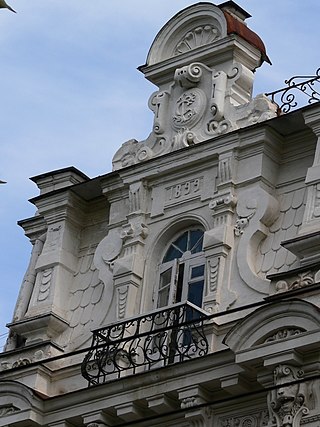
Vasily Vasilyevich Vereshchagin was one of the most famous Russian war artists and one of the first Russian artists to be widely recognised abroad. The graphic nature of his realist scenes led to many of them never being printed or exhibited.

Peredvizhniki, often called The Wanderers or The Itinerants in English, were a group of Russian realist artists who formed an artists' cooperative in protest of academic restrictions; it evolved into the Society for Travelling Art Exhibitions in 1870.

The State Tretyakov Gallery is an art gallery in Moscow, Russia, which is considered the foremost depository of Russian fine art in the world.

Konstantin Petrovich von Kaufmann, was the first Governor-General of Russian Turkestan.

Nikolay Nikolaevich Karazin was a Russian military officer, painter and writer. He is mostly known for his paintings depicting wars and exotic places.

The National Gallery of Armenia is the largest art museum in Armenia. Located on Yerevan's Republic Square, the museum has one of the most prominent locations in the Armenian capital. The NGA houses significant collections of Russian and Western European art, and the world's largest collection of Armenian art. The museum had 65,000 visitors in 2005.

Georg Bleibtreu was a German painter of military and historical scenes.

Hans Baluschek was a German painter, graphic artist and writer.
Alexander Alexandrovich Naumov was a Soviet, Russian painter, lived and worked in Saint Petersburg, member of the Saint Petersburg Union of Artists, regarded as a representative of the Leningrad school of painting, the most known for his works depicting Central Asia.

Georg Wilhelm Timm, also known as Vasily Fyodorovich Timm was a Baltic-German painter, lithographer and ceramic designer, known for his genre and battle scenes. He was also the publisher of the Russian Art Gazette.
The V. V. Vereshchagin Mykolaiv Art Museum is the museum of art, which is located in Mykolaiv, also known as Nikolayev, Ukraine.

Realism was an artistic movement that emerged in France in the 1840s, around the 1848 Revolution. Realists rejected Romanticism, which had dominated French literature and art since the early 19th century. Realism revolted against the exotic subject matter and the exaggerated emotionalism and drama of the Romantic movement. Instead, it sought to portray real and typical contemporary people and situations with truth and accuracy, and not avoiding unpleasant or sordid aspects of life. The movement aimed to focus on unidealized subjects and events that were previously rejected in art work. Realist works depicted people of all classes in situations that arise in ordinary life, and often reflected the changes brought by the Industrial and Commercial Revolutions. Realism was primarily concerned with how things appeared to the eye, rather than containing ideal representations of the world. The popularity of such "realistic" works grew with the introduction of photography—a new visual source that created a desire for people to produce representations which look objectively real.

Pyotr Petrovich Vereshchagin was a Russian landscape and cityscape painter in the Academic style. He was the first to paint plein-air in the wilderness of the Urals.

Ivan Nikolaevich Tereshchenko was a 19th-century Russian Imperial landowner, industrialist, art collector and patron of the arts of Ukrainian Cossack origin. He was renowned for his numerous art collections across Europe.

The conquest of Central Asia by the Russian Empire took place in the second half of the nineteenth century. The land that became Russian Turkestan and later Soviet Central Asia is now divided between Kazakhstan in the north, Uzbekistan across the center, Kyrgyzstan in the east, Tajikistan in the southeast, and Turkmenistan in the southwest. The area was called Turkestan because most of its inhabitants spoke Turkic languages with the exception of Tajikistan, which speaks an Iranic language.

Napoléon on the Battlefield of Eylau is an oil painting of 1808 by French Romantic painter Antoine-Jean Gros. Completed during the winter of 1807–1808, the work became an icon of the emerging style of French Romanticism. It depicts a moment from the aftermath of the bloody Battle of Eylau in which Napoléon Bonaparte surveys the battlefield where his Grande Armée secured a costly victory against the Russians. Although Napoleon on the Battlefield of Eylau retains elements of history painting, it is by far Gros's most realistic work depicting Napoleon and breaks from the subtlety of Neoclassicism. The painting is housed at the Louvre in Paris.

Suppression of the Indian Revolt by the English is a c. 1884 painting by Russian artist Vasily Vereshchagin. The work depicts several Sepoys being executed by being "blown from a gun" in the aftermath of the Indian Rebellion of 1857.
Vereshchagin's Turkestan Series is a collection of 13 paintings produced by Russian artist Vasily Vereshchagin in the 19th-century. While initially purchased en masse by a Russian collector, the works have since been added to the collections of the Tretyakov Gallery in Moscow and the Russian Museum in Saint Petersburg.

The siege of Samarkand was a military engagement fought in Samarkand, Uzbekistan in 1868 between the Russian Empire and a combined army of forces from the Bokharan Emirate, and several Uzbek tribes. During the engagement, a Russian garrison successfully repelled multiple attempts by the besieging allied army to storm the city. The Russian victory solidified imperial control over the new state of Russian Turkestan, and caused the partial collapse of the Bokharan Emirate.

The M. Kroshitsky Sevastopol Art Museum is an art museum located in the Crimean city of Sevastopol.

















